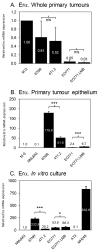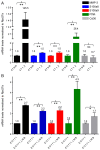Functional and molecular characterisation of EO771.LMB tumours, a new C57BL/6-mouse-derived model of spontaneously metastatic mammary cancer
- PMID: 25633981
- PMCID: PMC4348562
- DOI: 10.1242/dmm.017830
Functional and molecular characterisation of EO771.LMB tumours, a new C57BL/6-mouse-derived model of spontaneously metastatic mammary cancer
Abstract
The translation of basic research into improved therapies for breast cancer patients requires relevant preclinical models that incorporate spontaneous metastasis. We have completed a functional and molecular characterisation of a new isogenic C57BL/6 mouse model of breast cancer metastasis, comparing and contrasting it with the established BALB/c 4T1 model. Metastatic EO771.LMB tumours were derived from poorly metastatic parental EO771 mammary tumours. Functional differences were evaluated using both in vitro assays and spontaneous metastasis assays in mice. Results were compared to non-metastatic 67NR and metastatic 4T1.2 tumours of the 4T1 model. Protein and transcript levels of markers of human breast cancer molecular subtypes were measured in the four tumour lines, as well as p53 (Tp53) tumour-suppressor gene status and responses to tamoxifen in vivo and in vitro. Array-based expression profiling of whole tumours identified genes and pathways that were deregulated in metastatic tumours. EO771.LMB cells metastasised spontaneously to lung in C57BL/6 mice and displayed increased invasive capacity compared with parental EO771. By immunohistochemical assessment, EO771 and EO771.LMB were basal-like, as was the 4T1.2 tumour, whereas 67NR had a luminal phenotype. Primary tumours from all lines were negative for progesterone receptor, Erb-b2/Neu and cytokeratin 5/6, but positive for epidermal growth factor receptor (EGFR). Only 67NR displayed nuclear estrogen receptor alpha (ERα) positivity. EO771 and EO771.LMB expressed mutant p53, whereas 67NR and 4T1.2 were p53-null. Integrated molecular analysis of both the EO771/EO771.LMB and 67NR/4T1.2 pairs indicated that upregulation of matrix metalloproteinase-3 (MMP-3), parathyroid hormone-like hormone (Pthlh) and S100 calcium binding protein A8 (S100a8) and downregulation of the thrombospondin receptor (Cd36) might be causally involved in metastatic dissemination of breast cancer.
Keywords: Breast cancer; Estrogen receptor alpha; Metastasis; Syngeneic preclinical models; Tumour subtyping.
© 2015. Published by The Company of Biologists Ltd.
Figures






References
-
- Antoniou A. C., Kuchenbaecker K. B., Soucy P., Beesley J., Chen X., McGuffog L., Lee A., Barrowdale D., Healey S., Sinilnikova O. M., et al. CIMBA, SWE-BRCA; HEBON; EMBRACE; GEMO Collaborators Study; kConFab Investigators (2012). Common variants at 12p11, 12q24, 9p21, 9q31.2 and in ZNF365 are associated with breast cancer risk for BRCA1 and/or BRCA2 mutation carriers. Breast Cancer Res. 14, R33. - PMC - PubMed
-
- Arai K., Takano S., Teratani T., Ito Y., Yamada T., Nozawa R. (2008). S100A8 and S100A9 overexpression is associated with poor pathological parameters in invasive ductal carcinoma of the breast. Curr. Cancer Drug Targets 8, 243–252. - PubMed
-
- Aslakson C. J., Miller F. R. (1992). Selective events in the metastatic process defined by analysis of the sequential dissemination of subpopulations of a mouse mammary tumor. Cancer Res. 52, 1399–1405. - PubMed
-
- Atkinson K. E. (1989). An Introduction to Numerical Analysis. New York, NY: John Wiley and Sons.
Publication types
MeSH terms
Substances
LinkOut - more resources
Full Text Sources
Other Literature Sources
Molecular Biology Databases
Research Materials
Miscellaneous

